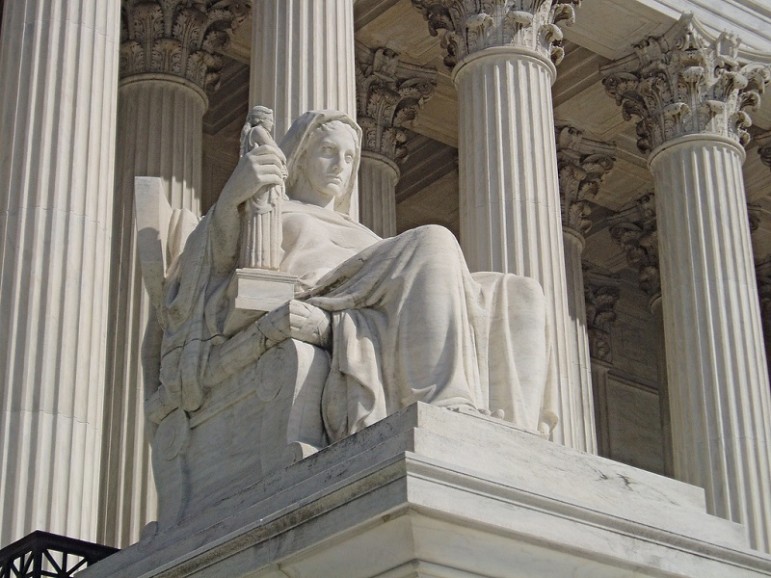
March 2, 2016; New York Times
More than a decade after it last heard a case on the subject, the Supreme Court of the United States heard its first major case involving abortion. The case concerns a 2013 Texas law that requires all abortions performed after 16 weeks to be performed in an ambulatory surgical center (ASC), potentially expensive facilities that are equipped to provide same-day surgical care, among other regulations regarding buildings and equipment. Clinics and challengers to the law contend several abortion clinics in Texas have shut down, depriving women of legally available healthcare options. The case comes after months of heavy campaigning to defund Planned Parenthood, leaving tensions high among activists on both sides of the abortion debate.
The case targets two portions of the 2013 law. One, as mentioned already, requires clinics to satisfy several regulations to continue to perform abortions. The other mandates the doctor performing an abortion to have admitting privileges at a hospital nearby. Lawmakers say the law is necessary to protect women and ensure abortions are safely performed, whereas clinics protest that the law only further limits the accessibility of abortion services.
In their brief to the Court, the Texas clinics challenging the law say:
The Texas requirements will not enhance abortion safety. Abortion is one of the safest and most common procedures in contemporary medicine. It typically involves either taking medication or undergoing a ten-minute procedure, without general anesthesia, in the outpatient setting of a doctor’s office or clinic.… Those requirements will instead make it harder for women to end a pregnancy safely by reducing their access to legal abortion.
According to the New York Times, as arguments started on Wednesday, the eight justices seemed evenly divided, with the three remaining conservative justices questioning whether there was enough evidence to conclude that clinics have closed or will close due to the restrictions in the law. Justice Anthony Kennedy, often identified as a “swing” vote on the Supreme Court, even suggested passing the case back to the lower court to gather more information. The four liberal justices remained steadfast that the law did not have any medical purpose and was unconstitutional.
Sign up for our free newsletters
Subscribe to NPQ's newsletters to have our top stories delivered directly to your inbox.
By signing up, you agree to our privacy policy and terms of use, and to receive messages from NPQ and our partners.
While the conservative justices may believe there isn’t enough information for them to decide the case, the clinics that brought suit adamantly charge that the law has already resulted in the closure of nearly half of Texas’s abortion clinics, which has had a precipitous effect on women. Fewer clinics keeping up with the same demand left many women delaying abortions, some even taking to self-induction at home. Joint studies released last November by the Texas Policy Evaluation Project released the first ever statistics on self-induction on the general population following the passage of the 2013 law. According to the studies, abortions in Texas declined by 13 percent just after six months after the law began to be enforced. In some cities, the wait times for abortions have lasted as long as 20 to 25 days, potentially endangering some women as their abortions are pushed into the second trimester of a pregnancy.
Although Justice Kennedy may think there isn’t enough evidence to consider the case, there is an effect when clinics close. The remaining clinics offering abortion services are clustered around metropolitan areas such as Austin, Dallas-Forth Worth, Houston, and San Antonio, leaving them inaccessible to those in more rural areas without transportation. Moreover, as the clinics allege in their brief, the clusters leave an entire area south and west of San Antonio—about the size of the state of California—without any clinics.
Despite the clinics’ efforts, there may already be some hints as to which direction the Supreme Court may vote. On February 24th, the Fifth Circuit Court upheld a similar restriction in Louisiana that would require doctors performing abortions to have admitting privileges at a nearby hospital. The Court found the law largely did not place an undue burden on one’s right to an abortion.
Regardless, the public was energized. The hearing brought pro-life and pro-choice activists out in hordes to the Supreme Court Wednesday morning, with demonstrations lining the sidewalks outside the courthouse. The last abortion case Gonzales v. Carhart (2007) upheld the federal Partial-Birth Abortion Ban Act.
There is no question that the dynamics of the court’s consideration of this case will be closely watched in the absence of Scalia.—Shafaq Hasan













